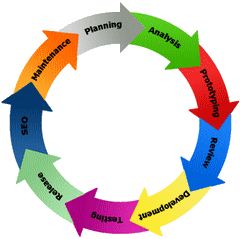The life cycle of a website...

As a client, you should plan to be involved in all three phases of the website life cycle shown below...
PHASE I - Plan
Working together we will focus on...
PHASE I - Plan
- Determine the purpose of your site - Attract business, sell products, provide promotional information, service customers, support your industry, increase business efficiency and productivity
- Content - What do you want your site to say
- Research - Study sites of your competitors, suppliers, related businesses/organizations, etc. to get ideas of what you like and dislike so your site can present your business or organization in the best way possible
- Determine your target audience - This can help guide the overall theme, content and layout
- Compile materials - Collect print and electronic copies of text content, existing promtional material, photos, logos, graphics, etc.
- Other considerations - Budget (how much to spen on development as well as monthly hosting fees), domain name - should be unique, easy to remember and relevant to your business name and service or purpose, Email - how many addresses do you need and who should have them
Working together we will focus on...
- Interface and navigation which will be efficient and intuitive
- Style and design - While being practical and functional, your site should also have aesthetic appeal, reflecting existing logos, colors and fonts as well as making a good impression and keeping readers attention
- Programming - your site will use code that is streamlined, browser compatible and ideally, browser independent
- Efficiency - code and graphics will be optimized for fast downloads
- Search engine/index/directory submission (general purpose). It's a good idea to work with us at least once a year to periodically check the listings and search engines for your website. We will update page content and SEO specific aspects of your site and resubmit as needed
- Integrate your website with your Social Media accounts and work with us to develop your Social Media Marketing strategy
- Listing in directories specific to your business, organization or location (trade associations, local chamber of commerce, etc.)
- Update all your printed material to reflect your website address and emails if needed (e.g. Letterhead, business cards, quotes, invoices, contracts, signage, print ads, etc.)
- Contact suppliers, customers and partners to discuss exchanging site links. This is good promotion and it can help your search engine rankings
- Always be aware of opportunities to add to your website and make it more useful
